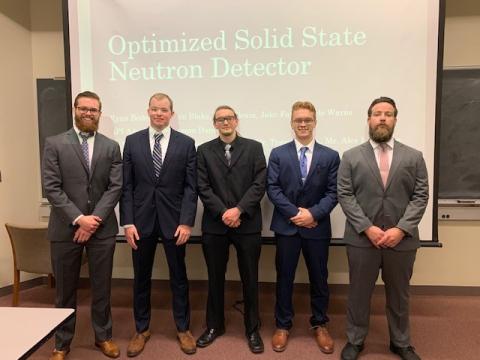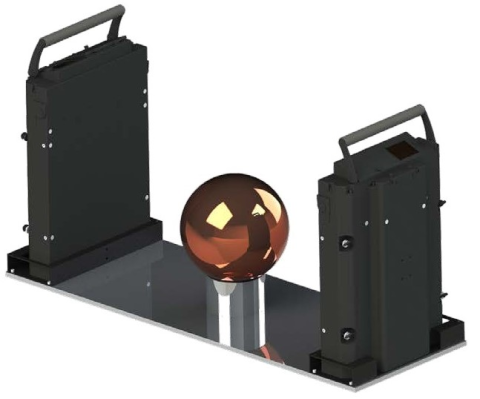This project focused on the design of a solid-state neutron detection system (SSND) for thermal neutrons to replace existing 3He based detector arrays, such as the Neutron Multiplicity Array Detector (NoMAD) used by the Advanced Nuclear Technology group at Los Alamos National Lab. NoMAD systems consist of two opposing units each containing 15 3He detectors in polyethylene moderator with a neutron source between them, as shown in Figure 1. For the purposes of this project and its definition of system efficiency, a single NoMAD unit was used for comparison purposes. Design focus of the SSND is to: 1) Based on existing semiconductor technologies, validate the viability of solid-state detectors as an alternative to 3He gas for thermal neutron detection, 2) Match overall efficiency (characterized via number of neutrons detected vs number incident on systems face) of a NoMAD unit while preserving the size envelope, 3) Investigate the spatial resolution potential afforded by the modular nature of solid-state detectors. Optimized design results and comparisons were conducted with extensive MCNP simulations of both SSND and NoMAD units utilizing a Cf-252 spontaneous fission source. Optimization was conducted through a multitude of iterative simulations to ensure detectors were located in regions of peak thermal neutron flux within a polyethylene moderator.
Team: Ryan Bedell, Camden Blake, Peter Brain, Jake Fay, Kyle Warns
Project Advisor: Prof. Danon

Members of the design group
Project Motivation
Neutron detectors play a pivotal role in ensuring the safety of nuclear technologies. Neutron detectors appear in an ever expanding array of applications from criticality research, nonproliferation, power plant operations, homeland security, to oil/gas exploration and mining. Demand for neutron detectors has far surpassed the dwindling global supply of 3He gas used in traditional detectors; causing prices to soar and thousands of projects around the country to remain fettered. As advancements in semiconductor fabrication techniques lead to exciting developments in the world of solid-state neutron detection. Solid-State neutron detectors have to potential to surpass 3He as the detection medium of choice, as they can be manufactured cheaply, require less voltage to operate, and provide greater spatial resolution than a 3He detector. These advantages do come at the expense of efficiency.

Figure 1- Neutron Multiplicity Array Detector (NoMAD) - Hutchinson, J. (n.d.). Subcritical Copper-Reflected α-phase Plutonium (SCRαP) Sphere Benchmark.
Project Description
This project focused on the design of a solid-state neutron detection system (SSND) for thermal neutrons to replace existing 3He based detector arrays, such as the Neutron Multiplicity Array Detector (NoMAD) used by the Advanced Nuclear Technology group at Los Alamos National Lab. NoMAD systems consist of two opposing units each containing 15 3He detectors in polyethylene moderator with a neutron source between them, as shown in Figure 1. For the purposes of this project and its definition of system efficiency, a single NoMAD unit was used for comparison purposes. Design focus of the SSND is to: 1) Based on existing semiconductor technologies, validate the viability of solid-state detectors as an alternative to 3He gas for thermal neutron detection, 2) Match overall efficiency (characterized via number of neutrons detected vs number incident on systems face) of a NoMAD unit while preserving the size envelope, 3) Investigate the spatial resolution potential afforded by the modular nature of solid-state detectors. Optimized design results and comparisons were conducted with extensive MCNP simulations of both SSND and NoMAD units utilizing a Cf-252 spontaneous fission source. Optimization was conducted through a multitude of iterative simulations to ensure detectors were located in regions of peak thermal neutron flux within a polyethylene moderator.

Figure 2 – Solid-State Neutron Detector (SSND), configuration shown matching target unit size without additional moderator cards installed.
Results and Accomplishments
Following an extensive review of existing commercial and experimental solid-state detector designs, a 10B (n,α) reaction based detector with a honeycomb microstructure on a P-n junction Silicon base was selected for use in SSND. While maintaining the overall footprint of LANL’s NoMAD, the optimized SSND (Figure 2) has a simulated detection efficiency within 1% of the target set by NoMAD with a bare Cf-252 source (15.37%). Slight modification to the depth of the system while preserving the incident neutron area, SSND’s efficiency surpassed its target by more than 1.5%. As the basis of comparison is used in criticality research, no neutron reflectors were used in the design. Capitalizing on the modular capacity of the solid-state detector selected, SSND has the ability to output between 320 and 6144 channels of data with no appreciable signal degradation. Individual channels can be tailored from a maximum 4 cm X 4 cm array of detectors, down to a 1 cm X 1 cm individual detector unit. If each detector outputs its own signal, SSND is capable of providing the location of a detection event to a 1 cm3 location within the detector. Subsequent simulations catalogued SSND’s response to 18 additional neutron sources. With a fully modular and interchangeable design, SSND is not limited to one out of the box configuration. Number of detectors, output channel arrays, detector type and location can easily be modified by the end user to suit their needs. SSND has also bee equipped with rapid augmentation system, enabling additional moderator, target specimens, or reflectors to the face of the unit without disassembly. SSND provides comparable efficiency with greater spatial resolution, is highly adaptable and highly saleable. Semiconductor based solid-state neutron detectors are cheaper than traditional 3He detectors and prove to be a viable alternative, paving the way for a new era of research, safety and security.